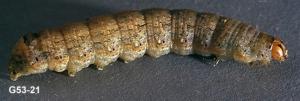CONTENTS
Identification
Management
Sampling
and Action Threshold
Development Model
Registered
Insecticides
References
[Insect
Management]
[Home]
|
|
 
Variegated cutworm, Peridroma saucia, is a common pest of many vegetable and
field crops, including mint. They overwinter as half grown larvae in soil or under plant
debris in or around mint fields. Larvae begin feeding in April and mature in late April
and May. Larvae pupate in earthen cells in the soil. Adults emerge in May and early June
and deposit eggs in clusters of 200 to 500 on the undersides of leaves. Eggs hatch in 4 to
7 days and larvae begin feeding on plant foliage. Larvae feed for 4 to 6 weeks and then
pupate in the soil. Larvae cause the most damage to mint in late July and early August.
Summer generation adults emerge in late August and deposit eggs. Larvae hatching from
these eggs feed until cold weather and then become inactive and overwinter. There are two
overlapping generations each year. In IPMP3.0, there is a variegated cutworm development
model, and a variegated cutworm economic threshold program. See also the section on variegated cutworm management and control.

Often the larvae of other species occur on and
defoliate mint at about the same time as the variegated cutworm. Bertha
armyworm, Memestra configurata, is often seen in mint fields, particularly
west of the Cascade Mountains. Its life cycle is about the same as that of the variegated
cutworm. However, at times Bertha armyworm larvae may be present before detectable
populations of variegated cutworm. Because its leaf feeding damage usually occurs earlier
in the growth of mint and its population density is generally less than that of variegated
cutworm, it is important to distinguish between the two species. An early insecticide
application against this species may not necessarily control variegated cutworm. One
well-timed remedial application for cutworms and loopers reduces cost and pesticide load
on the field, and minimizes other possible problems, such as the induction of spider mite
problems, destruction of beneficial insects, and increased pressure for resistance
development in pest insects. |



